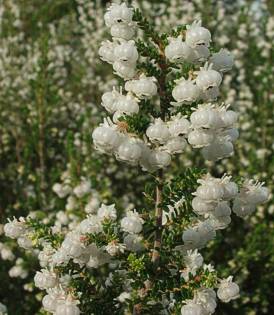Erica formosa
Erica formosa Thunb.
Family: Ericaceae
Common names: white heath (Eng.); witheide (Afr.)
Introduction
Erica formosa is a charming plant that produces lovely displays of white flowers from midwinter to early summer. It is well-tempered and keeps a neat tidy habit for many years without requiring much maintenance and therefore should be one of the first choices when planning a fynbos garden.

Description
Description
Erica formosa is a compact, much-branched, bushy shrublet, up to 600 mm tall. It has small, dark, shiny, green leaves arranged close to thin stems. It produces a profusion of small, glossy, white flowers shaped like rounded or urn-shaped bells that are contracted at the throat. A distinctive feature of this species is the eight grooves or channels in the flowers. It often grows in colonies producing splashes of white on hillsides from July to November.

Conservation Status
Status
Erica formosa is common along the southern Cape coast and mountain ranges and as such has been classified in the Red List as Least Concern.
Distribution and habitat
Distribution description
Erica formosa is found along the coastal flats and lower, moist, south-facing mountain and hill slopes from the Swellendam District to Mossel Bay, extending eastwards to Humansdorp. It is also found inland as far as the Kammanassie Mountains situated between the Swartberg and Outeniqua Mountains east of Oudtshoorn. It normally grows in colonies where the soil is well drained, but slightly clayey.
Derivation of name and historical aspects
History
The species name of Erica formosa is derived from the Latin word, formosus, which means beautiful.
Ecology
Ecology
Erica formosa grows on damp, south-facing hills or mountain slopes. It prefers well-drained, acidic soils with some clay content. It has a neat compact habit and grows in colonies or nestles in amongst other fynbos plants which provide it with protection. This species also grows close to the sea (where it is much smaller) on the windswept hills such as along the Otter Trail.
Uses
Use
Erica formosa is quite hardy in Mediterranean conditions or areas where there is no frost. It has a neat growth habit and is a good edging plant, which can be used in mass displays. A combination of this white-flowered species in mass displays with the pink buchu species, Coleonema pulchellum planted behind, and the smaller Acmadenia heterophylla in front, will be most rewarding. It is a very good pot plant and requires only the minimum of clipping to retain a good shape.

Growing Erica formosa
Grow
Erica formosa grows best when planted in gardens in full sunlight. It can also grow in light shade, but will produce less compact plants and fewer flowers.
It is ideal for rockeries, embankments or any open plant bed where the soil is well drained and acidic. Companion fynbos plants may include other ericas, buchus, brunias, and small restios. It will also do well in a medium-sized container with a suitable, well-drained growing medium. A f ynbos planting medium is made up of a combination of equal parts of composted pine bark or pine needles and river sand. A little (20%) loam may also be added.
It does not require much pruning, but pruning after flowering is recommended to keep the plants compact. Plants that are pruned are more presentable, last longer and produce more flowers.
Erica plants are adapted to living in poor soils and therefore should be regularly fed with diluted organic liquid or small amounts of organic pellet fertilizers.
It is propagated vegetatively by rooting fresh, semi-hardwood, tip or heel cuttings in multi-trays on heated benches under mist spray. Cuttings are rooted in autumn or spring in a medium of equal parts bark and polystyrene chips. A semi-hardwood rooting hormone is used to aid this process. This species grows easily from seed sown in well-drained, acidic, sandy soil and subjected to smoke treatment. Seed is normally sown from late summer into autumn, i.e. March to May.
References
- Baker, H.A. & Oliver, E.G.H. 1967. Ericas in southern Africa. Purnell, Cape Town & Johannesburg.
- Goldblatt, P. & Manning, J.C. 2000. Cape plants. A conspectus of the Cape flora of South Africa. Strelitzia 9. National Botanical Institute, Cape Town and Missouri Botanical Garden.
- Oliver, E.G.H. & Oliver, I.M. 2002. The genus Erica (Ericaceae) in southern Africa : taxonomic notes 1. Bothalia 32: 37-61.
- Schumann, D. & Kirsten, G. 1992. Ericas of South Africa. Fernwood Press, Vlaeberg, Cape Town.
- Smith, C.A. 1966. Common names of South African plants. Memoirs of the Botanical Survey of South Africa No. 35.
- website: http://www.sanbi.org/biodiversity/reddata.htm.
Credits
Anthony Hitchcock
Kirstenbosch National Botanical Garden
September 2009
Plant Attributes:
Plant Type: Shrub
SA Distribution: Western Cape
Soil type:
Flowering season: Spring, Early Summer, Winter
PH: Acid
Flower colour: White
Aspect:
Gardening skill: Average
Special Features:
Horticultural zones







Rate this article
Article well written and informative
Rate this plant
Is this an interesting plant?
Login to add your Comment
Back to topNot registered yet? Click here to register.